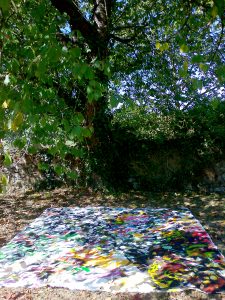Lorategian
2010
Due to different circumstances and as an attempt to recover some or other basic feature of the figure of the romantic painter, Veva Linaza has embarked on a shift to landscapes. A shift that does not imply gazing at or travelling through it, but also a physical experimentation with it. The garden emerged as one of the first habitats for the romantic painter. The Lorategian series, paintings and drawings that begin to be shifted by the sunlight, under the trees of the garden, thus emerged.
The garden emerges as the first of the habitable grounds by the figure of the romantic painter. The garden as a sylvan replica or controlled forest model. A first window that frames the unknown and is used to present a governable and contained reality. [First basic feature of romantic impossibility?]
In this way, the Lorategian series arises, paintings that begin to move through the sunlight, under the trees in the garden.
The set of these paintings is made on the ground, using the lights and shadows of the vegetation that are projected onto the fabrics. In this way she takes up the value of horizontality, and with it, the movement of escape of the elements that painters are trying to catch when painting and that apparently never reach [Second basic feature of romantic impossibility?]
The sunlight beats branches, leaves, herbs and any element that tries to unfold in its verticality. Everything collapses on the ground, plummets and thus its expansion becomes horizontal. The landscape becomes a shadow
Then, at the end of each session and lifting the fabrics from the floor, the sensation of seeing images appear that visually bounce the projected, and as unwittingly, again elude the representation.
There are also drawings in watercolour, coal and wax. Fragments of paper, which together form large format drawings.
The essays on the paper, in their way, show the time of landscape through projections (trees and leaves, herbs …) that are clearly shown on white paper. The light that filters to the paper under the shadows generates a subtle displacement that goes unnoticed and that can only be seen when one distances oneself from the trace.
The drawing should be done quickly, taking advantage of every second that passes as the shadow moves unperturbed, continuously changing the reality of the projected element. The shadow escapes the paper and the paper escapes the stroke.
Search and construction work of spaces in movement. The passage of time. The memory, which is in transit, which is no longer there, that, cannot be contained. [Third basic feature of romantic impossibility?]
Lorategian
2010
En un intento por recuperar algún que otro rasgo básico de la figura imposible del pintor romántico, Veva Linaza plantea un desplazamiento hacia paisaje. Un desplazamiento que implica, no solo una mirada o un recorrido por el mismo, sino una experimentación física sobre él. Una pintura que podríamos decir, germina por ósmosis lumínica…
El jardín surge como el primero de los terrenos habitables por la figura del pintor romántico. El jardín como réplica selvática o modelo de bosque controlado. Una primera ventana que enmarca lo desconocido y es utilizada para presentar una realidad gobernable y contenida. [¿Primer rasgo básico de imposibilidad romántica?]
Surge de este modo la serie Lorategian, cuadros que comienzan a moverse mediante la luz del sol, bajo los árboles del jardín.
El conjunto de estas pinturas se realiza en el suelo, utilizando las luces y sombras de la vegetación que se proyectan sobre las telas. De este modo retoma el valor de la horizontalidad, y con él, el movimiento de escape de los elementos que se intentan atrapar al pintar y que al parecer nunca se alcanzan [¿Segundo rasgo básico de imposibilidad romántica?]
La luz del sol abate ramas, hojas, hierbas y cualquier elemento que trata de desplegarse en su verticalidad. Todo se desploma en el suelo, cae en picado y así su expansión se torna horizontal. El paisaje se convierte en sombra.
Después, al terminar cada sesión y levantar las telas del suelo, surge la sensación de ver cómo aparecen imágenes que visualmente rebotan lo proyectado, y como sin quererlo, vuelven a eludir la representación.
También hay dibujos en acuarela, carbón y cera. Fragmentos de papel, que unidos configuran dibujos de gran formato.
Los ensayos en el papel ponen, a su modo, en evidencia el tiempo del paisaje a través de proyecciones vegetales (árboles y hojas, hierbas…) que se muestran nítidas sobre el papel blanco. La luz que se filtra al papel bajo las sombras genera un desplazamiento sutil que pasa desapercibido y que únicamente puede verse cuando uno se distancia del trazo.
El dibujo debe de hacerse deprisa, aprovechando cada segundo que pasa ya que la sombra se desplaza imperturbable, cambiando continuamente la realidad del elemento proyectado. La sombra se escapa del papel y el papel se escapa del trazo.
Trabajo de búsqueda y construcción de espacios en movimiento. Paso del tiempo. El recuerdo, lo que está en tránsito, lo que ya no está. Lo que no puede contenerse.
[¿Tercer rasgo básico de imposibilidad romántica?]
